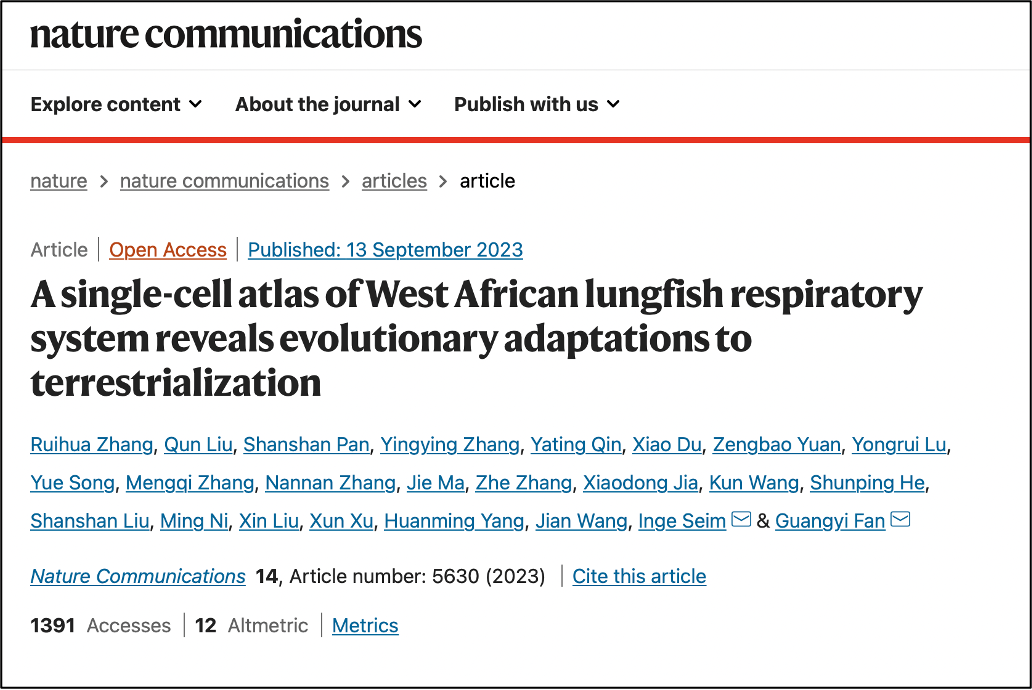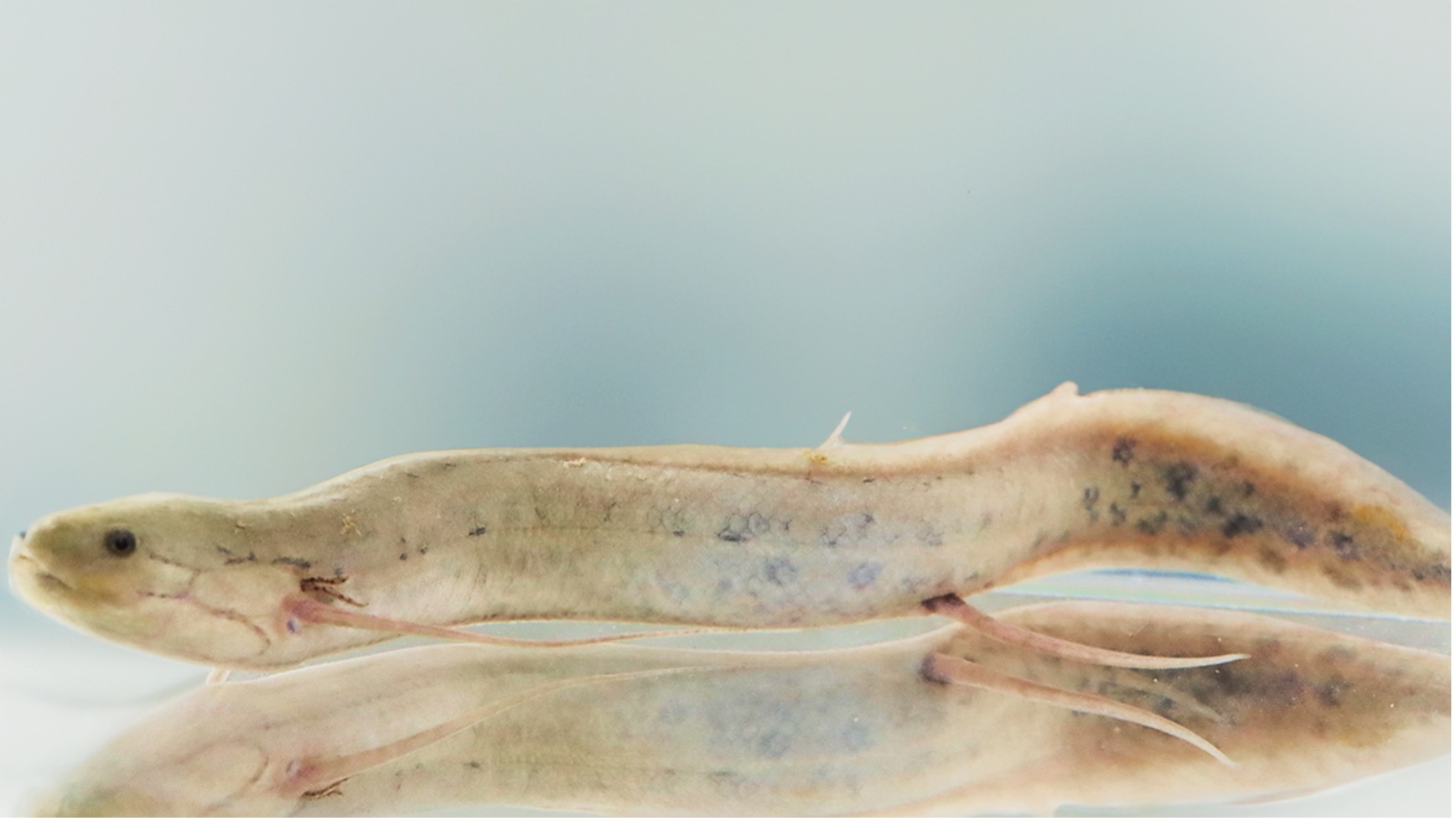On September 13th, BGI-Research published its latest findings on the respiratory organs of the West African lungfish in Nature Communications. This research has produced the most comprehensive high-resolution single-cell atlas of the West African lungfish (Protopterus annectens) respiratory system to date in both terrestrial and aquatic environments. It provides essential evidence for further exploration of the mysteries surrounding vertebrate organ evolution. The achievement also marks another breakthrough in this field following BGI-Research's participation in constructing the world's first complete genome of the West African lungfish in 2021.
 The study “A single-cell atlas of West African lungfish respiratory system reveals evolutionary adaptations to terrestrialization” published in Nature Communications.
The study “A single-cell atlas of West African lungfish respiratory system reveals evolutionary adaptations to terrestrialization” published in Nature Communications.
Unlike typical fish, lungfish possess a unique ability to surface and inhale oxygen in air. Much like many marine mammals, lungfish are obligatory air breathers, meaning they must periodically access the atmosphere for oxygen to ensure their survival.
 West African Lungfish
West African Lungfish
Furthermore, the West African lungfish can enter a dormant state on dry land during extreme droughts, enduring many months even years in mud burrows without water or food until the rainy season returns.
The transition of vertebrates from water to land is a pivotal event in evolutionary history. The African lungfish, with the West African lungfish being one of its modern subcategories, has been present on Earth for over 400 million years. As an ancient species and the closest living relative to tetrapods, the West African lungfish possesses numerous transitional features in the course of evolution, representing an intermediate form between fish and amphibians. It is considered a key species in deciphering the evolution of vertebrates from aquatic to terrestrial life.
One remarkable feature of the West African lungfish is its multiple respiratory systems, with lungs as the primary respiratory organ in both aquatic and terrestrial environments, supplemented by gills and skin for respiration. Among these, the lung structure of the West African lungfish exhibits primitive characteristics similar to the lungs of modern vertebrates, making it a crucial species for studying the evolution of respiratory organs in tetrapods.
The research team conducted sequencing on 53,605 cells from the lung tissue of the West African lungfish and 87,347 cells from the gill tissue. These samples were taken from two groups, a 33-day laboratory-induced dormancy group and a control group. Utilizing previously published West African lungfish genome data, the team identified 14 cell types in the lung and 22 cell types in the gills.
 Lung and Gill cell landscape of from terrestrialized and freshwater lungfish.
Lung and Gill cell landscape of from terrestrialized and freshwater lungfish.
To further uncover the changes in organs and tissues during the transition of early vertebrates from water to land, the research team conducted a detailed comparison of lung and gill tissues between the West African lungfish dormancy group and the control group based on the single-cell atlas they created. The results showed that short-term dormancy did not lead to an increase or loss of cell types. However, some crucial cells, such as lung alveolar epithelial cells and gill proliferative cells, exhibited significant downregulation in cellular metabolism during dormancy.
Additionally, the research team conducted cross-species comparative analyses at the cellular and gene expression regulatory levels using previously published single-cell data on key vertebrate respiratory organs. The results demonstrated that despite the primitive structural characteristics of the West African lungfish's lungs, its basic cellular composition and key gene expression patterns showed a high degree of similarity to higher mammals, indicating the fundamental functionality of mammalian lungs. These findings further confirm the homology of West African lungfish with typical vertebrate respiratory organs.
 A high degree of gene expression similarity among zebrafish swim bladder, lungfish lung, mouse lung, and human lung.
A high degree of gene expression similarity among zebrafish swim bladder, lungfish lung, mouse lung, and human lung.
"The evolutionary status of the West African lungfish is quite unique, and studying its respiratory system can shed light on the changes that occurred during the vertebrate transition to land," said Dr. Fan Guangyi, co-corresponding author of the article and Director of the Institute of Digital Earth at BGI-Research. "The single-cell atlas constructed in this study comprehensively describes the cellular composition of the West African lungfish respiratory organs, providing valuable resources for exploring the evolution and adaptation of vertebrate respiratory systems in future research."
The project underwent ethical review and adheres to relevant regulations.
Read the article: https://www.nature.com/articles/s41467-023-41309-3



